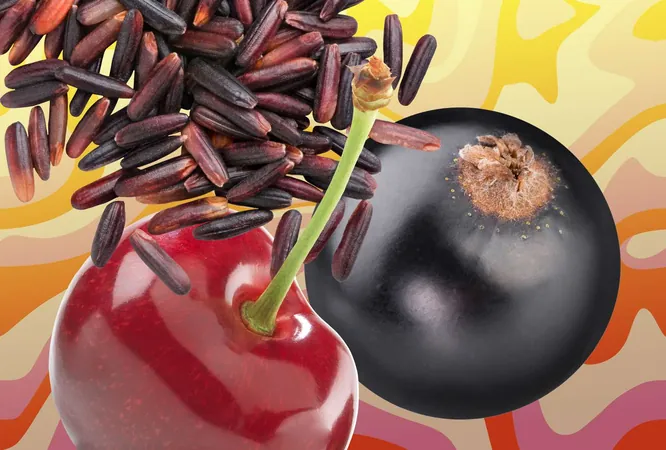
Uncovering 5 Surprising Foods Packed with More Anthocyanins Than Blueberries!
2025-05-04
Author: Yan
When it comes to powerhouse superfoods, blueberries often steal the spotlight. Their delightful flavor is just one of the reasons they are celebrated for enhancing heart health, reducing diabetes risk, and combating inflammation. But do you know what gives them that stunning blue hue? It’s all thanks to anthocyanins—a type of antioxidant pigment!
However, blueberries aren’t the only food rich in these vibrant nutrients. Anthocyanins are abundant in a variety of other red, blue, and purple plants, creating a rainbow of healthy options for your plate. These compounds not only add color but also play a crucial role in fighting diseases.
Eager to spice up your diet while reaping those antioxidant benefits? We consulted dietitians to reveal their top choices—foods that boast even more anthocyanins than our beloved blueberries.
Understanding Anthocyanin Content
It’s essential to recognize that the anthocyanin content can vary significantly among foods due to multiple factors: climate, cultivation methods, and even the type of berry. For reference, cultivated blueberries contain around 80-160 milligrams of anthocyanins per 100 grams, with wild varieties typically packing even more. So, let’s see which foods take the crown!
1. Blackberries: The Juicy Dark Horse
If you want a berry that rivals blueberries, look no further than blackberries. "The darker the berry, the more anthocyanins it tends to contain,” says dietitian Alison Ellis. Blackberries can reach about 100-138 milligrams of anthocyanins per 100 grams, making them a formidable antioxidant contender. Plus, they are higher in fiber than blueberries—providing nearly double! Toss them in a salad or top your morning toast for a delicious twist.
2. Black Currants: A Tart Super Berry
With a stunning anthocyanin content of 113-158 milligrams per 100 grams, black currants are a true hidden gem. These small, tart berries boast a potent antioxidant profile that can help support heart health and combat oxidative stress. Though harder to find fresh in the U.S., they shine in jams, desserts, and even wine! Spread some black currant jam on your breakfast toast for a tasty treat.
3. Cherries: Summery Sweetness Packed with Benefits
Sweet cherries, particularly black cherries, can contain up to 169 milligrams of anthocyanins per 100 grams. Cherries not only help fight inflammation but are also rich in vitamin C and fiber. While eating them by the handful is tempting, try using them in a cherry-almond farro salad for an elegant dish.
4. Elderberry: The Immune Booster
Elderberries aren't just tasty; they’re anthocyanin powerhouses, hitting as high as 485 milligrams per 100 grams! However, caution is key—these berries need to be cooked to avoid toxicity. They make delightful syrups for immune support and can elevate your smoothies or teas to a whole new level.
5. Black Rice: The Nutritional Grain Star
Who said only fruits and veggies hold the antioxidant crown? Enter black rice, or forbidden rice, rich in anthocyanins at about 456 milligrams per 100 grams. This ancient grain not only provides a gorgeous deep purple color but also offers significant fiber, iron, and minerals. Try it in a coconut black rice bowl with tofu or a zesty shrimp dinner for a delightful twist.
The Bottom Line: Color Your Plate for Health!
Don’t underestimate the power of red, blue, and purple foods! They are bursting with anthocyanins that offer a myriad of health benefits. While blueberries remain a top pick, branching out to blackberries, black currants, elderberries, cherries, and black rice could enhance your diet and amplify your health in delicious ways!

 Brasil (PT)
Brasil (PT)
 Canada (EN)
Canada (EN)
 Chile (ES)
Chile (ES)
 Česko (CS)
Česko (CS)
 대한민국 (KO)
대한민국 (KO)
 España (ES)
España (ES)
 France (FR)
France (FR)
 Hong Kong (EN)
Hong Kong (EN)
 Italia (IT)
Italia (IT)
 日本 (JA)
日本 (JA)
 Magyarország (HU)
Magyarország (HU)
 Norge (NO)
Norge (NO)
 Polska (PL)
Polska (PL)
 Schweiz (DE)
Schweiz (DE)
 Singapore (EN)
Singapore (EN)
 Sverige (SV)
Sverige (SV)
 Suomi (FI)
Suomi (FI)
 Türkiye (TR)
Türkiye (TR)
 الإمارات العربية المتحدة (AR)
الإمارات العربية المتحدة (AR)